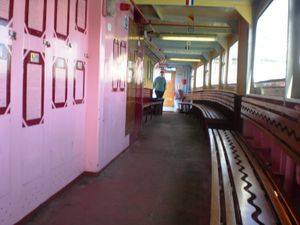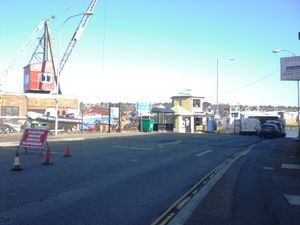Cowes Floating Bridge
| Cowes Floating Bridge | |
| 250px | |
|---|---|
| A car loading onto the floating bridge. | |
| Route | |
| Crosses | River Medina |
| Carries | Up to 20 cars |
| Service | |
| Operator | Isle of Wight Council |
| Ferry(s) | 1 (No. 5) |
| Type | Chain ferry |
| Travel time | 2-3 minutes |
| Frequency | Continuous while open |
| History | |
| Opened | 1859 |
| Predecessor | Floating Bridge Company Steam Packet Company |
The Cowes Floating Bridge is a vehicular chain ferry which crosses the River Medina on the Isle of Wight, off the south coast of England. The ferry crosses the tidal river from East Cowes to West Cowes. The first floating bridge between East Cowes and West Cowes was established in 1859 and is one of the few remaining that has not been replaced by a physical bridge. The service is owned and operated by the Isle of Wight Council, who have run it since 1901. Prior to ownership by the local authority the service has been run by The Floating Bridge Company and The Steam Packet Company. The ferry currently used is named No. 5, the fifth to be owned by the Isle of Wight Council, and eighth in total. It was built in 1975 and can carry up to 20 cars. The Cowes floating bridge remains the only way to cross the River Medina between the towns without taking a ten kilometre trip via Newport. Recently, as part of a private finance initiative by the Isle of Wight Council, it has been mentioned that the current vessel could be replaced, if agreed by the cabinet.
History
Before any kind of floating bridge existed, a rowing boat ferry operated between Cowes and East Cowes transporting pedestrians only. This service was owned and operated by the Roberton family from 1720 to 1859. From 1842 cars and animals could be transported across using a pontoon which was winched across under horse power. In 1859 the Floating Bridge Company was formed and bought the ferry rights. From 24th November 1859 the first steamboat was used, built on the River Itchen in Southampton. In 1868 the ferry was bought by the Steam Packet Company (now part of Red Funnel), and bought a new ferry for the service in 1882. This was used regularly until 1896 when it was used only as a spare when a new ferry was purchased.[1]
The route was first taken over by the local authority in 1909, when the West and East Cowes Urban Councils took over operation. With this, a new ferry was bought and started the system of naming vessels still used today, by numbering them in order of acquisition, the first being named Bridge No.1. These newer bridges were significantly different from past designs, with Bridge No.1 featuring power ramps and electric lighting and was built from steel. In 1925 Bridge No.2 was built, being the last steam powered ship. It was larger than any that had previously operated the route at over 100 ft long (30 m), with a capacity for eight cars. This was later sold on for use at Sandbanks when Bridge No.3 was built and arrived in 1936, being the first diesel-electric powered vessel. Bridge No.4 entered service in 1952 with a capacity for 12 cars. This was used regularly until 1975 when the current Bridge No.5 arrived with a capacity of up to 20 cars. From 1982 there were no reserve vessels in place for the route, leaving Bridge No.5 as the sole ferry operated.[1][2] In 1988 a direct bus service was created between Ryde and West Cowes which involved the bus travelling over on the floating bridge. Small buses had to be used to guarantee space on the crossing, however the service was withdrawn by 1990.
In 2006 the Isle of Wight Council considered converting the floating bridge to only transport vehicles across the River Medina, setting up a launch for pedestrians with a charge of 50p. Prior to this the last time a foot passenger charge was in operation was until 1992, when the vehicle tolls were raised from 75p to £1.25 to compensate for any lost income. While this initially resulted in a slump in sailings from 300,000 to less than 210,000 in 1993, as the diversion travelling via Newport became more congested the popularity of the floating bridge began to rise again. The argument was put forward that by taking out passenger compartments the overall capacity of the ferry could be increased by up to 30 per cent. Following this it was hoped with a prudent approach to future toll increases the ferry route could become profitable. It has historically always made a loss.[3] However, the idea of introducing a charge was very unpopular with local residents, councillors and businesses and the threat receded.[4]
Occasionally the idea of replacing the chain ferry with a swing bridge or tunnel is brought up, however this has yet to materialise into any major debate.[5] Additionally, the the ferry used for the service now looks set to be replaced as part of a £400 million private finance initiative for island transport which would be likely to push back such a debate even further. If the replacement is agreed by the cabinet, the outline business case will be sent to the government for approval.[6]
Current operations
The ferry operates 365 days a year, normally for around 18 hours a day between 05:00 to 00:30, although starts slightly later on Sundays.[7] There are regular crossings at around every 10-15 minutes, however as it is a continuous service, there is no formal timetable produced. Public transport connections are available on both sides by Southern Vectis bus route 1 in Cowes and routes 4 and 5 in East Cowes linking to Newport and Ryde.[8] Annually, the floating bridge transports around 1.5 million pedestrians and 400,000 vehicles.[9] At certain times of the year the ferry is unable to operate as it goes through an annual refit. During this time a foot passenger ferry is operated, however the only alternative for vehicles is to travel along the River Medina and cross at Newport.
As of August 2008 onwards, the one-way toll for a car, van, tractor, or motorcycle and sidecar was set at £1.50. Motorcycles are £0.90. Foot passengers and cyclists may cross for free.[7] Books of tickets are available giving discount to regular users of 20 for £17.50. In 2009 the Isle of Wight Council were planning to reduce the discount given through the scheme. The decision was however reversed due to the impact this would have on residents and visitors.[10] From April 2010, due to a large deficit in the Isle of Wight Council's budget the standard one-way toll at £1.50 is set to be increased to £1.80.[11]
The tidal nature of the River Medina can periodically restrict operations of the floating bridge during times very low tides. In September 2007 exceptionally low tides caused by a full moon resulted in the river being too shallow for the bridge to operate.[12] Similarly in 2003 the ferry was left stranded on the banks of the East Cowes side of the river as the tide decreased due to difficulties with a vehicle disembarking the vessel, leaving it grounded. It was then unable to move until the next high tide later on in the day.[13]
References
- ↑ 1.0 1.1 "Cowes on the Isle of Wight - Floating Bridge". www.simplonpc.co.uk. http://www.simplonpc.co.uk/Cowes.html. Retrieved 2009-12-03.
- ↑ Hall, Nick (November 2006). "Chained links". Ships Monthly (IPC Country & Leisure Media): pp. 17–21.
- ↑ "End of line for free floating bridge travel?". Isle of Wight County Press. http://www.iwcp.co.uk/news/end-of-line-for-free-floating-bridge-travel-13406.aspx. Retrieved 2010-01-24.
- ↑ "Floating bridge fare threat ebbs". Isle of Wight County Press. http://www.iwcp.co.uk/news/floating-bridge-fare-threat-ebbs-13471.aspx. Retrieved 2010-01-24.
- ↑ "Powerful backing for dynamic Cowes plan". Isle of Wight County Press. http://www.iwcp.co.uk/news/powerful-backing-for-dynamic-cowes-plan-1698.aspx. Retrieved 2009-12-02.
- ↑ "New floating Bridge". Isle of Wight County Press. http://www.iwcp.co.uk/news/news/new-floating-bridge-27786.aspx. Retrieved 2009-08-08.
- ↑ 7.0 7.1 "Timetable and Fares". Isle of Wight Council. http://www.iwight.com/council/departments/engineering_services/transport_fleet/Cowes_Chain_Ferry/Timetable__Fares/. Retrieved April 12, 2007.
- ↑ "Southern Vectis route list". Southern Vectis. http://www.islandbuses.info/routelist.shtml. Retrieved 2009-12-04.
- ↑ "Isle of Wight Council Transport Section - Cowes Floating Bridge". Isle of Wight Council. http://www.iwight.com/council/departments/engineering_services/transport_fleet/Cowes_Chain_Ferry/. Retrieved 2009-12-04.
- ↑ "Rethink over bridge tickets discount". Isle of Wight County Press. http://www.iwcp.co.uk/news/news/rethink-over-bridge-tickets-discount-25921.aspx. Retrieved 2009-05-01.
- ↑ "Spending up but cuts hurt". Isle of Wight County Press. http://www.iwcp.co.uk/news/news/spending-up-but-cuts-hurt-31068.aspx. Retrieved 2010-02-05.
- ↑ "Extra-low tide halts floating bridge". Isle of Wight County Press. http://www.iwcp.co.uk/news/extralow-tide-halts-floating-bridge-17508.aspx. Retrieved 2010-01-17.
- ↑ "Floating bridge left high and dry". Isle of Wight County Press. http://www.iwcp.co.uk/news/floating-bridge-left-high-and-dry-803.aspx. Retrieved 2010-01-17.
External links
| Cowes Floating Bridge
]]- Isle Of Wight Council page on the Cowes Chain Ferry, includes pictures.
- History of the Cowes Chain Ferry
| |||||
Coordinates: 50°45′27.7″N 1°17′29.3″W / 50.757694°N 1.291472°W



